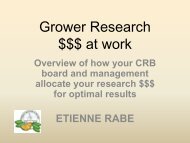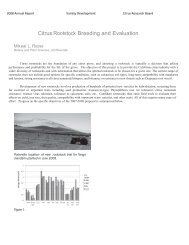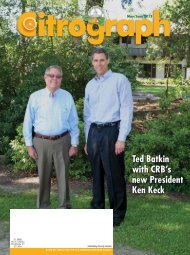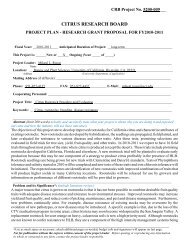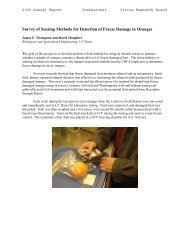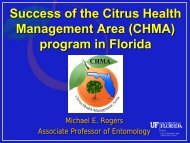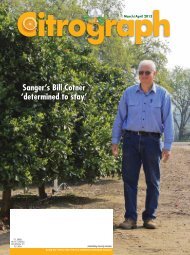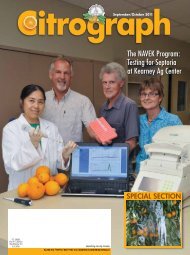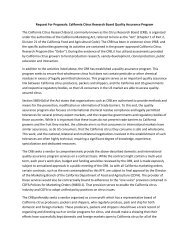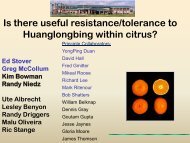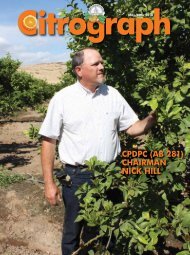Beth Grafton-Cardwell and her team at Lindcove - Citrus Research ...
Beth Grafton-Cardwell and her team at Lindcove - Citrus Research ...
Beth Grafton-Cardwell and her team at Lindcove - Citrus Research ...
You also want an ePaper? Increase the reach of your titles
YUMPU automatically turns print PDFs into web optimized ePapers that Google loves.
have been consistent <strong>and</strong> are good to excellent as long as<br />
the fruit are not left hanging on the tree. The harvest season<br />
for this cultivar in Florida should occur from the middle of<br />
November through the end of the calendar year.<br />
The first evalu<strong>at</strong>ion of trees of ‘USDA 6-15-150’ grown<br />
in California occurred in 2009. Based on the 2009 <strong>and</strong> 2010<br />
results <strong>at</strong> both Exeter <strong>and</strong> Riverside demonstr<strong>at</strong>ion blocks,<br />
fruit were already above legal m<strong>at</strong>urity by mid-October <strong>at</strong><br />
Exeter <strong>and</strong> mid-October to early November <strong>at</strong> Riverside, but<br />
the external rind color was still very green <strong>and</strong> did not reach<br />
color break until about a month l<strong>at</strong>er <strong>at</strong> Exeter. Two samples<br />
of 10 fruit of ‘USDA 6-15-150’ collected from Exeter <strong>and</strong> Riverside<br />
for three sample d<strong>at</strong>es in 2009 <strong>and</strong> four sample d<strong>at</strong>es<br />
in 2010 had an average of 11.8 seeds per fruit. The fruit from<br />
both loc<strong>at</strong>ions <strong>at</strong> all sample d<strong>at</strong>es were only slightly fl<strong>at</strong>tened<br />
in shape (average length/width r<strong>at</strong>io of 0.90) with medium<br />
orange flesh color. The four-year-old trees in Riverside have<br />
medium vigor <strong>and</strong> are approxim<strong>at</strong>ely 5.0 ft. in height with a<br />
5 ft. diameter with a spreading growth habit.<br />
‘USDA 6-15-150’ m<strong>and</strong>arin, CVC, Riverside, CA. 1/12/2011.<br />
Photo by T. Siebert<br />
SRA 513 Bahianinha navel (VI 699) <strong>and</strong> Bahianinha<br />
Araras navel (VI 700): First distribution of buds from the<br />
CCPP: September 2010. These two selections of Bahianinha<br />
navel oranges have slightly different introduction histories.<br />
‘SRA 513 Bahianinha’ navel was apparently developed in<br />
Piracicaba, Sao Paulo, Brazil, <strong>and</strong> don<strong>at</strong>ed to INRA, San Giuliano,<br />
Corsica, France, in 1971. It was received by the CCPP<br />
in 1997. ‘Bahianinha Araras’ navel is reported to have been<br />
developed <strong>at</strong> the Instituto Agronomico do Estado Sao Paulo<br />
Campinas, Sao Paulo, Brazil. It was received by the USDA-<br />
ARS Horticultural <strong>Research</strong> St<strong>at</strong>ion in Ft. Pierce, Florida, in<br />
1940 <strong>and</strong> obtained by the CCPP in 1999.<br />
The origin of the variety ‘Bahianinha’, which is the source<br />
of these two selections, is a bit of a mystery. Although ‘Bahianinha’<br />
(also called ‘Bahianinha Piracicaba’) was presumed to<br />
have origin<strong>at</strong>ed as a bud mut<strong>at</strong>ion from the ‘Washington’ or<br />
‘Bahia’ navel orange, in the 1st edition of “The <strong>Citrus</strong> Industry”<br />
(1943), Webber presented evidence th<strong>at</strong> it may not have<br />
origin<strong>at</strong>ed in Brazil, as commonly supposed. This variety was<br />
found in a planting of navel orange trees <strong>at</strong> Piracicaba, Sao<br />
Paulo St<strong>at</strong>e of Brazil, about 1907-1908 with budded trees imported<br />
from the United St<strong>at</strong>es, presumably Florida(Hodgson,<br />
1967). This variety is also reported to be unstable <strong>and</strong> to have<br />
given rise to two smaller-fruited selections, Ivers <strong>and</strong> Thomazzelli<br />
(Hodgson, 1967).<br />
According to “The <strong>Citrus</strong> Industry” (1967), ‘Bahianinha’<br />
differs from ‘Parent Washington’ in having smaller, more<br />
oval-shaped fruit with a smaller, closed navel <strong>and</strong> a thinner<br />
rind. It is st<strong>at</strong>ed to be productive but smaller <strong>and</strong> less vigorous<br />
30 Citrograph July/August 2011<br />
than ‘Parent Washington’. It is one to two weeks earlier than<br />
‘Parent Washington’ <strong>and</strong> has good fruit quality when grown<br />
on an appropri<strong>at</strong>e rootstock. It is st<strong>at</strong>ed to be less prone to<br />
altern<strong>at</strong>e bearing than ‘Parent Washington’. These differences<br />
are st<strong>at</strong>ed to be less pronounced in California as compared to<br />
Brazil. ‘Bahianinha’ (‘Bahianinha Piracicaba’) became popular<br />
in Brazil due to its desirable size for the export market.<br />
It is better adapted to hot, tropical clim<strong>at</strong>es than is ‘Parent<br />
Washington’ <strong>and</strong> has more recently been planted extensively<br />
in the Corrientes Province of neighboring Argentina due to<br />
this characteristic (Hodgson, 1967). The differences between<br />
the various strains of ‘Bahianinha’ <strong>and</strong> the selections imported,<br />
especially under California conditions, remain unclear.<br />
The first evalu<strong>at</strong>ion of trees of these two selections of<br />
‘Bahianinha’’ grown in California occurred in October 2010.<br />
Based on the 2010 fruit quality evalu<strong>at</strong>ions from Riverside,<br />
w<strong>her</strong>e fruit of both ‘Bahininha’ selections were available, ‘Bahianinha<br />
Araras’ (averaged solids to acid r<strong>at</strong>io 8.8 <strong>and</strong> Brim<br />
A 5.0) <strong>and</strong> ‘Washington’ (averaged solids to acid r<strong>at</strong>io 11.9<br />
<strong>and</strong> Brim A 7.0) navel fruit reached legal m<strong>at</strong>urity by mid-<br />
October, but the rind was green in color. The ot<strong>her</strong> SRA selection<br />
reached legal m<strong>at</strong>urity by the early November sample<br />
d<strong>at</strong>e (averaged solids to acid r<strong>at</strong>io 10.7 <strong>and</strong> Brim A 6.3). All<br />
three cultivars were past color break by this early November<br />
sample d<strong>at</strong>e. In Riverside, the four-year-old trees of the SRA<br />
513 selection had strong vigor <strong>and</strong> are approxim<strong>at</strong>ely 6.0 ft. in<br />
height with a 6.0 ft. diameter with a spreading dense growth<br />
habit. The four-year-old trees of the Araras selection had<br />
strong vigor as well but were approxim<strong>at</strong>ely 5.5 ft. in height<br />
with a 5.0 ft. diameter with a spreading dense growth habit.<br />
‘SRA 513 Bahianinha’ navel, CVC, Riverside, CA. 2/25/2010.<br />
Photo by D. Karp <strong>and</strong> T. Siebert<br />
‘Bahianinha araras’ navel, CVC, Riverside, CA. 2/25/2010.<br />
Photo by D. Karp <strong>and</strong> T. Siebert<br />
Verna lemon (VI 701): First distribution of buds from the<br />
CCPP: September 2010. ‘Verna’ lemon (also known as ‘Berna’<br />
lemon) is a Spanish variety of unknown origin, possibly<br />
arising in Murcia, Spain, from ‘Monachello’ lemon (Agusti,<br />
2000). Verna was obtained by the Instituto Valenciano de<br />
Investigaciones Agrarias in Valencia, Spain, <strong>and</strong> sent to the<br />
CCPP in 2002.<br />
The ‘Verna’ is a well-established lemon variety in Spain<br />
but has not been planted outside of th<strong>at</strong> country to any extent.<br />
Gonzalez-Sicilia (1968) st<strong>at</strong>es th<strong>at</strong> ‘Verna’ is the lemon<br />
variety most cultiv<strong>at</strong>ed in the Levant, accounting for 90-100 %



